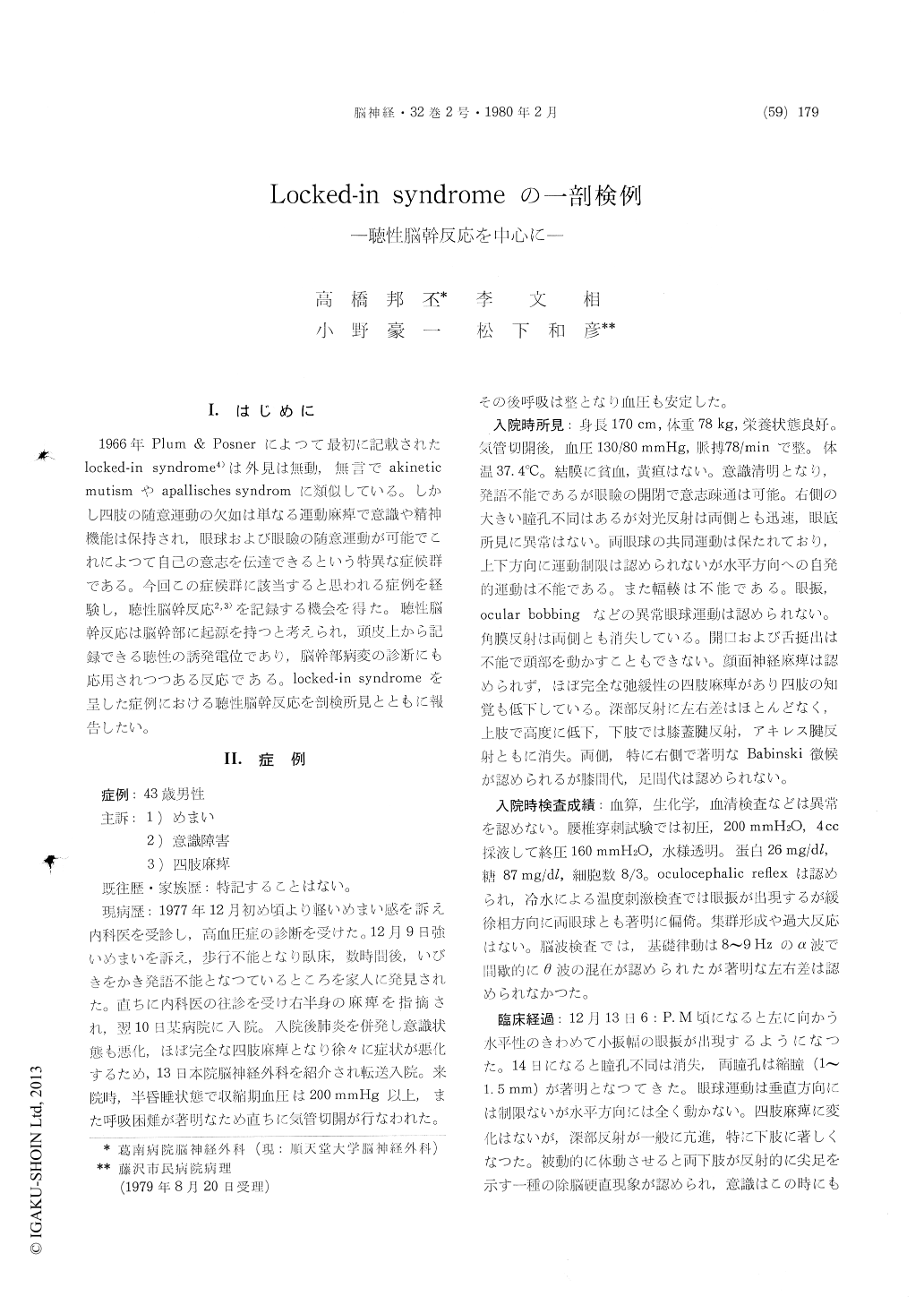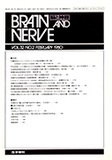Japanese
English
- 有料閲覧
- Abstract 文献概要
- 1ページ目 Look Inside
Ⅰ.はじめに
1966年Plum & Posnerによつて最初に記載された10cked-in syndrome4)は外見は無動,無言でakineticmutismやapallisches syndromに類似している。しかし四肢の随意運動の欠如は単なる運動麻痺で意識や精神機能は保持され,眼球および眼瞼の随意運動が可能でこれによつて自己の意志を伝達できるという特異な症候群である。今回にの症候群に該当すると思われる症例を経験し,聴性脳幹反応2,3)を記録する機会を得た。聴性脳幹反応は脳幹部に起源を持つと考えられ,頭皮上から記録できる聴性の誘発電位であり,脳幹部病変の診断にも応用されつつある反応である。locked-in syndromeを呈した症例における聴性脳幹反応を剖検所見とともに報告したい。
A 43-year-old man was admitted to the hospital with the chief complaints of vertigo, consciousness disturbance and tetraplegia. He had severe pneu-monia and prominent dyspnea. After admission, tracheostomy was performed. He recovered con-sciousness shortly after the tracheostomy, but he was unable to control his body except for his eyes along a vertical plane. He could make him-self understood by moving his eyelids and his eyes along a vertical plane. He was dignosed as a case of locked-in syndrome. Angiography showed oc-clusion of the basilar artery. CT-scan also revealed the low density area in the ventral part of the brain-stem. EEG showed a waves of 8-9 Hz and no asymmetry. He had no nystagmus nor ocular bobbing. Caloric nystagmus was induced by cold caloric stimutation, but both eyes deviated toward the stimulation side. About 5 weeks after the admission, he began to gnash his teeth involuntarily, and it lasted about two weeks.
Auditory evoked brain-stem response (BSR) was recorded repeatedly every two weeks during the course of his illness over a period of about three months. Voltage was slightly low, but the BSR showed an almost normal pattern, and the latency of each wave was within normal limits.
The patient died of pneumonia three months after admission. About two days before of hisdeath, when he had high fever, transient ocular bobbing was observed for few hours. Autopsy revealed marked atherosclerosis of the basilar artery and ventral pontine infarction. The infarction was marked in the middle of the pons, and the upper and lower pons showed unilateral infarction of the right ventral side. A small infarction was observed in the right lower ventral midbrain contiguous to the pons. The cerebrum, berebellum and medulla oblongata were not affected. These autopsy find-ings verified the pathology of typical locked-in syndrome. On the other hand, the auditory path-ways in the brain-stem, cochlear nucleus, superior olivary complex, lateral lemniscus ... etc., were not at all disturbed. This finding supported the normal BSR recordings.
In 1977, Gilroy reported on the auditory evoked brain-stem potentials in a case of locked-in syndrome showing the prolonged latency of waves, especially waves IV and V. In our case, however, significant prolonged latency of these waves was not observed.

Copyright © 1980, Igaku-Shoin Ltd. All rights reserved.


